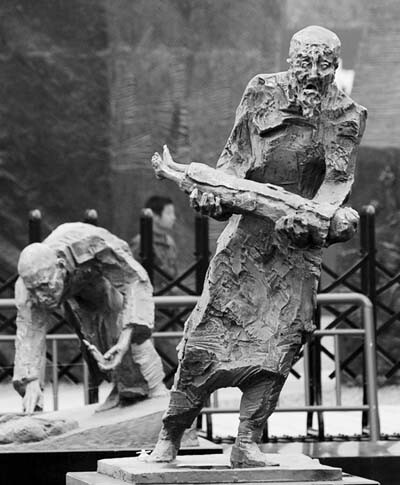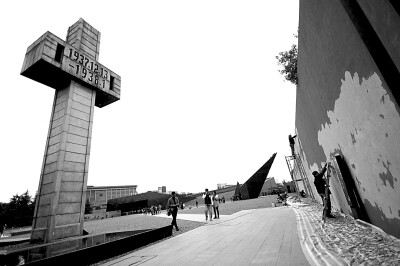Defending facticity of Nanjing Massacre

Sculptures depict civilians fleeing from the havoc.

The Memorial Hall of the Victims in Nanjing Massacre by Japanese Invaders
From 1946 to 1948, the perpetrators of the Nanjing Massacre (also known as Nanking Massacre)were put on trial by the Court-martial of the Department of Defense formed by the Nationalist Government and the International Military Tribunal for the Far East successively. The massacre was legally confirmed and established as fact by the two courts.
However, it was not until three decades later that academic research on the Nanjing Massacre started flourishing. This delayed progress can be explained as the result of systematic denials and distortions of history by Japanese conservatives. Research on the subject has become increasingly incisive and broad with the growing awareness in Chinese society of the country’s tragic modern history and the true meaning of patriotism.
Collective victimhood
In the catastrophic massacre, the city of Nanjing and nearby areas suffered massive loss of life and property. As recorded by American missionary writings, German documents and firsthand account of Xia Shuqin, a survivor of the massacre, the tragic experience of Xia’s family was enshrined in the Memorial Hall of the Victims in Nanjing Massacre by Japanese Invaders, serving as an authentic illustration of past suffering.
The Nanjing Massacre traumatized not only local civilians but also refugees from Shanghai, Wuxi and elsewhere. To a larger extent, the massacre was targeted at the Nationalist combat troops who had already ceased fighting at the final stage of the Battle of Nanjing, including the 60th, 71th, 72th, 74th, 78th, 83th armies, provost forces, and cadet corps of the Central Military Academy. Soldiers were recruited from across the nation, so few of them were Nanjing natives.
Foreigners were also victimized by the atrocity. While searching for Chinese combatants at local refugee camps on Dec. 16, 1937, Japanese soldiers terrorized Charles Riggs, the deputy director of the City Housing Committee, with fists and bayonets. James McCallum, president of Gulou Hospital, was stabbed in the neck and almost died. Both of them were Americans. The German diplomat Georg Rosen and many Westerners barely managed to escape death. Moreover, those who witnessed the massacre were haunted by Post-traumatic Stress Disorder, a subtle yet no less devastating form of injury. The American missionary George Fitch was agitated by intermittent amnesia while disseminating truth of the Nanjing Massacre in America. Wilhelmina Vautrin, a female American missionary and educator, almost surrendered to suicidal thoughts. Much to our grief, Iris Zhang (Zhang Chunru), the author of the Rape of Nanking and Nanking Massacre, finally committed suicide as she could no longer bear the unceasing nightmares triggered by the subjects of her books.
Universal testimonies
Based on their occupational status, foreign witnesses can be categorized into three groups: correspondents, diplomats, and expatriates enlisted in the boards of local voluntary organizations.
Five foreign correspondents witnessed the Nanjing Massacre reporting, for American publications the Chicago Daily News, the New York Times, Reader’s Digest, the Washington Post and Life.
Writings of American, Britain, and German diplomatic personnel also attested to the havoc. For instance, John Allison, John Espy, and Archibald Alexander McFadyen worked at the American embassy at the time. They collected relevant accounts from foreign expatriates and reported the terror to the American government.
Similarly, Westerners who oversaw the International Committee for the Nanking Safety Zone and the International Committee of the Red Cross kept a vast amount of documents, diaries, correspondences and reports, reaffirming the authenticity of journalistic and diplomatic accounts. Notable examples were narratives of the German business representative and official John Rabe, American missionaries Lewis Smythe and John Magee.
The vast amount of evidence left by these witnesses appeared in four collections.
Members of the International Committee for the Nanking Safety Zone and the International Committee of Red Cross made plenty of records, while saving Chinese people from the savage acts of Japanese armies. These records were compiled into a separate archive, which was subsequently titled the Documents of the Nanking Safety Zone. According to these documents, Japanese soldiers committed 444 heinous crimes in the safety zone and nearby areas from Dec. 15, 1937 to Feb. 7, 1938.
Yale University Divinity School Library Special Collections house seven records: a press release written by Miner Bates, missionary correspondences, photographs taken by Ernest Forster, telegraphs made from American diplomatic personnel, Documents of the Nanking Safety Zone, The Diaries of John Rabe, The Wartime Diaries of Minnie Vautrin. It is worth mentioning that Bates had also investigated organized drug trade and totalitarian economic control imposed by Japanese military authority, local response to Japanese occupation and activities of the Nanking International Relief Committee.
American diplomatic personnel wrote a number of analyses and witness testimonies before and after the fall of Nanjing. In addition, individuals and groups from other Western countries often kept copies of their telegraphs and correspondences with Japanese authorities at Ameri can embassy at that time, which explained the presence of comments and instructions left by the Secretary of the State Cordell Hull on relevant copies.
Depictions of the calamity also can be found in an assortment of memoirs and reportage works. The Guardian journalist Harold Timperley published What War means: The Japanese Terror in China in New York and London in 1938. Overseas readers were shocked by the content of the book.
Magee secretly filmed the city’s wartime suffering. To the best of our knowledge, the film is the only documentar footage testifying to the massacre. Smythe and his students conducted field research in Nanjing and nearby areas in 1938. Based on this experience, he published Portrayals of the Nanking Havoc. Other notable works included John Powell’s and Fitch’s memoirs and Cabot Coville’s inspection report.
In addition, scholars also unearthed relevant documentary materials in Britain, Demark, Russia, Italy and Spain. These materials were preserved in the voluminous A Collection of Historical Records on the Nanking Massacre. Records left by foreigners reveal that the Nanjing Massacre not only victimized the Chinese people but also amounted to an overwhelmingly excruciating chapter of global wartime memory.
Defending the memory
Among all war crimes inflicted upon Chinese people by Japanese armies, the Nanjing Massacre is unique in the sense that Japanese military officers involved in the atrocity were prosecuted twice. Starting from Feb. 15, 1946, the first prosecution was initiated by Court-martial of Army Force Command of Nationalist Government, which was later renamed the Court-martial of the Department of Defense. Based on international and domestic criminal laws, the court sentenced Toshiaki Mukai, Hisao Tani, and Tsuyoshi Noda to death for their involvement in the “contests to kill 100 people using a sword” during the massacre.
In the second prosecution, known as the Tokyo Trials, 28 Class-A Japanese war criminals were put on trial by the International Military Tribunal for the Far East from May 1946 to November 1948. Given that the Nanjing Massacre was overwhelmingly catastrophic, the tribunal decided to process it as a separate case.
The tribunal was modeled on the American court system. Every defendant was assigned a Japanese and an American counselor. Plaintiff and defense attorneys were required to present evidence and witnesses in support of their own stances and allowed to cross-examine those of opposing witnesses. Plaintiffs and defendants were granted with equal rights and obligations. Eventually, Iwane Matsui, the chief culprit of the massacre, was found guilty and sentenced to death by the court. The Japanese Government acknowledged the verdicts of the two prosecutions in the Treaty of San Francisco in Sept 8, 1951.
Despite unequivocal official acknowledgement, Japanese conservative groups have constantly denied the existence of the Nanjing Massacre. Though the arguments took on various forms, they were not so different from the sophistic reasoning underlying Matsuiwa’s self-justification, the perjuries of Japanese witnesses, and the contention of defense attorneys.
The main arguments were thus: Matsuiwa is a peace lover who emphasized self-discipline, and soldiers strictly observed his orders. Atrocities in Nanjing were never widely established and acknowledged as facts before the Tokyo Trials. There was no military command authorizing systematic slaughter. Local life remained uninterrupted before and after the occupation. Japanese soldiers were seduced by local women but never assaulted them. Testimonies from Western witnesses were either unreliable or outright fabrications. The tribunal showed favoritism in its judgment. Defense attorney’s remarks concerning female victims of wartime Nanjing were well-grounded.
Japanese conservatives have continued to push the envelope. They contend that their country’s post-war pacifistic inclination is a sign of masochism. To shed the “masochistic mentality,” they have to attack the factuality of the Nanjing Massacre because the city’s suffering amounted to an irrefutable accusation against Japan’s militaristic past and shaped the historical consciousness of victim countries. In this light, when Chinese government and society strive to defend the historicity of the Nanjing Massacre, they are defending the interest of all countries that heroically resisted Japanese invasion.
Zhang Sheng is a professor from the Department of History at Nanjing University.
